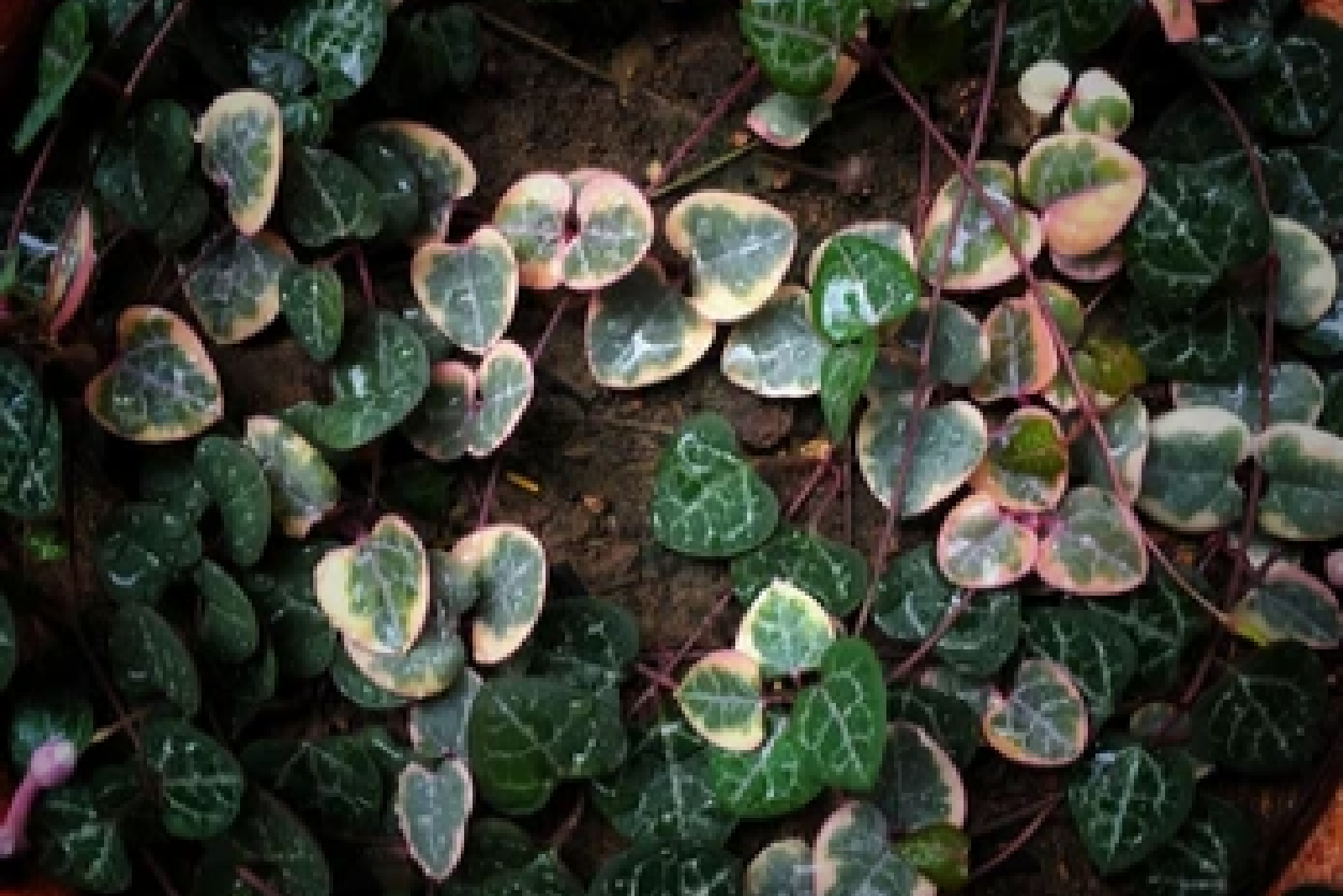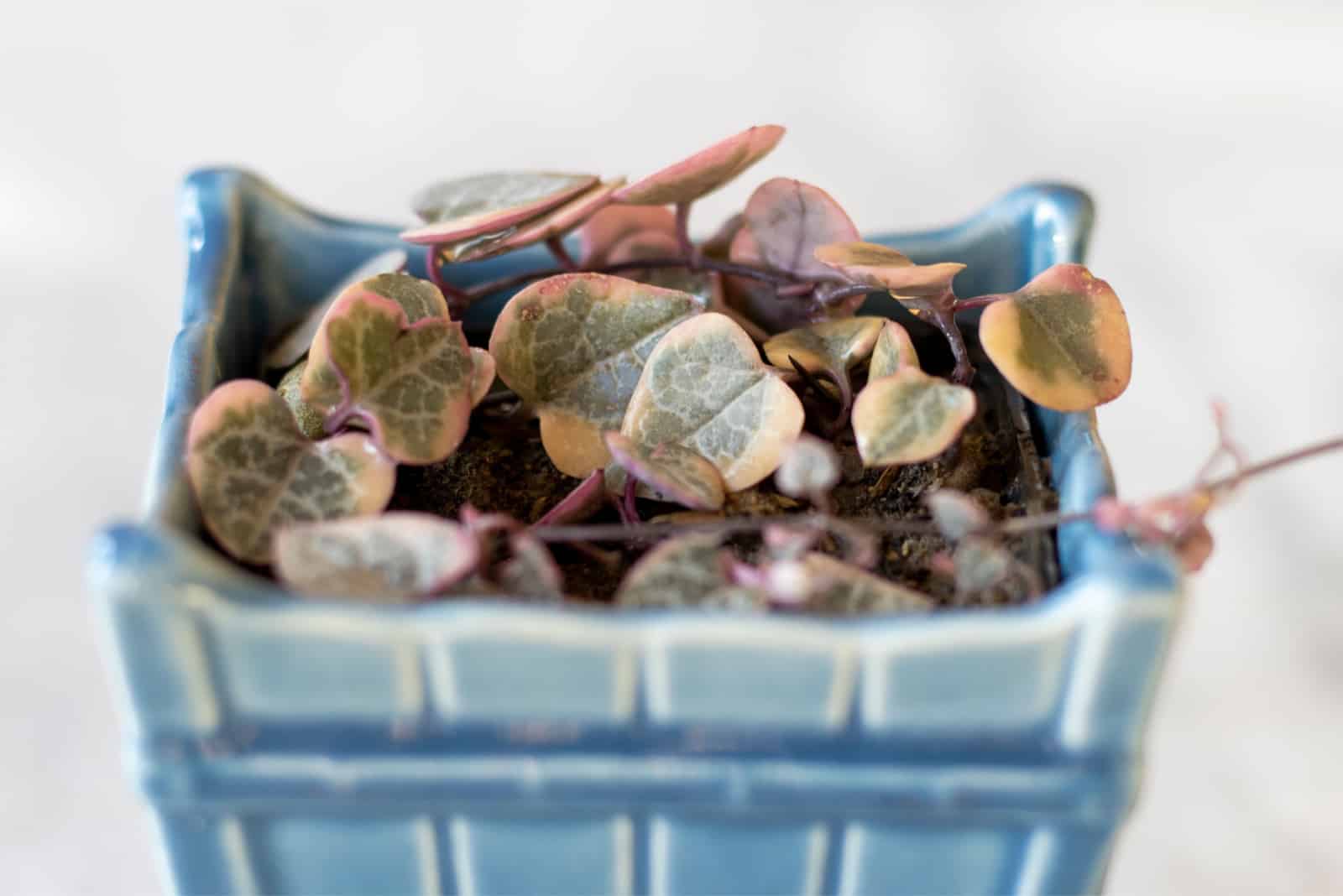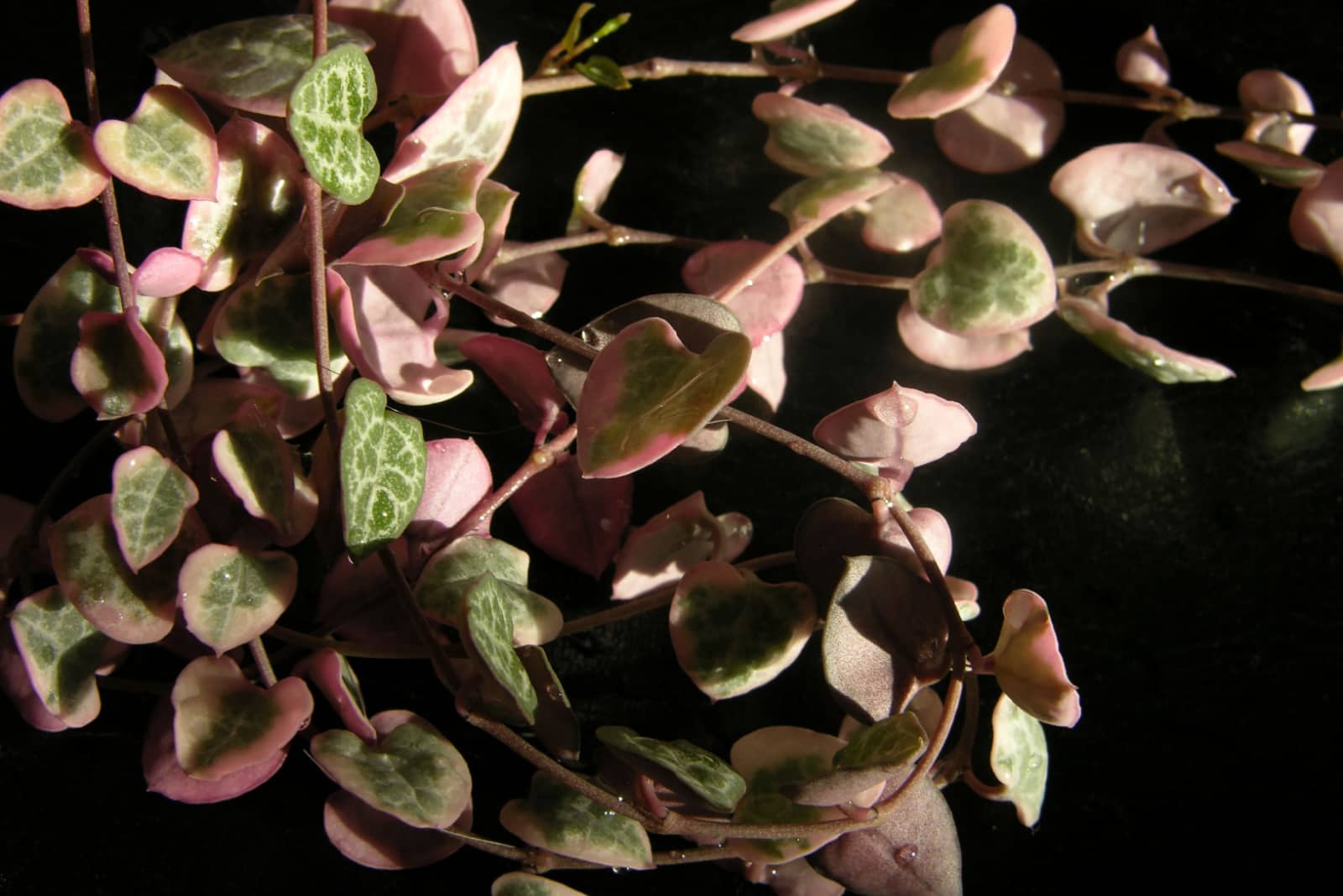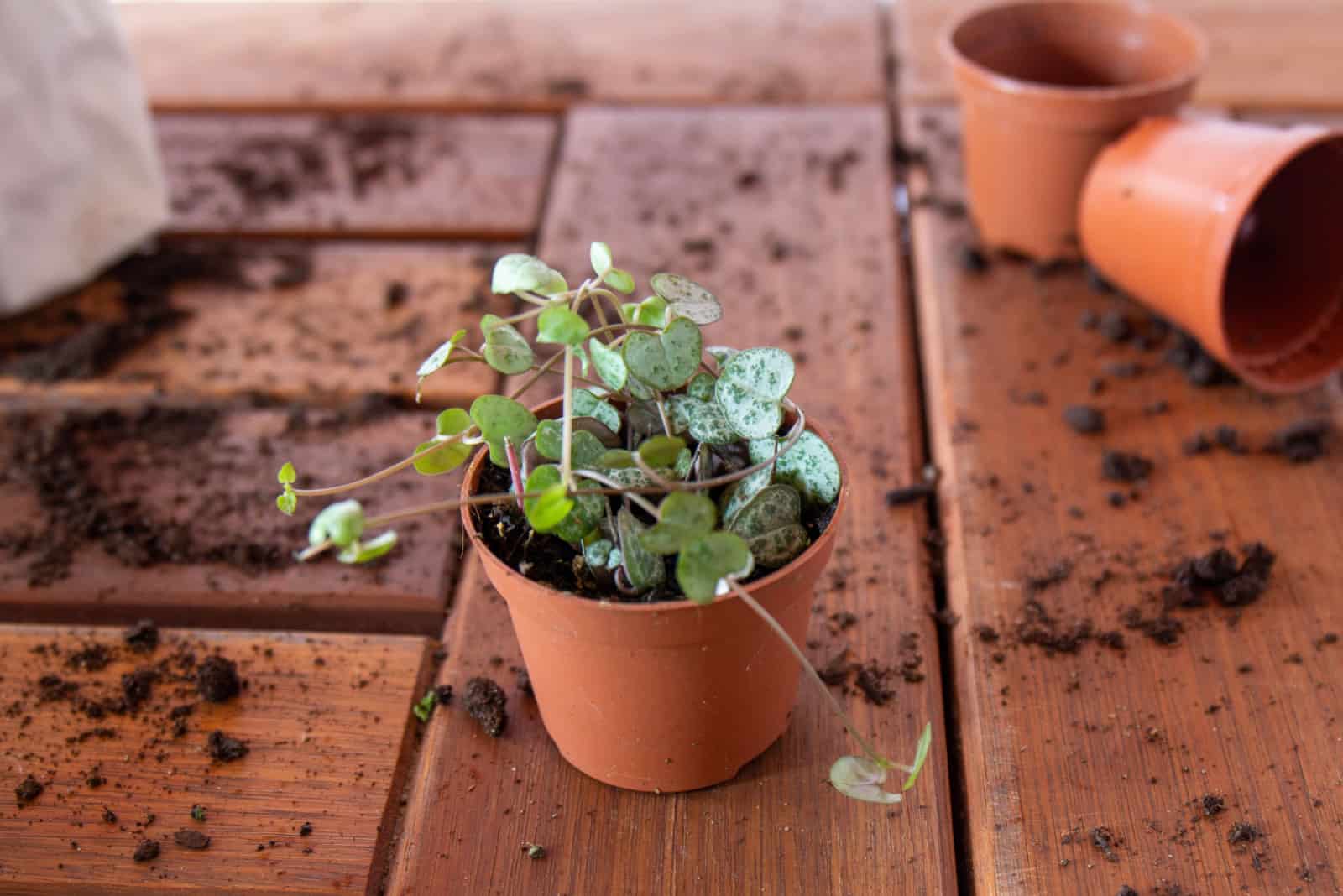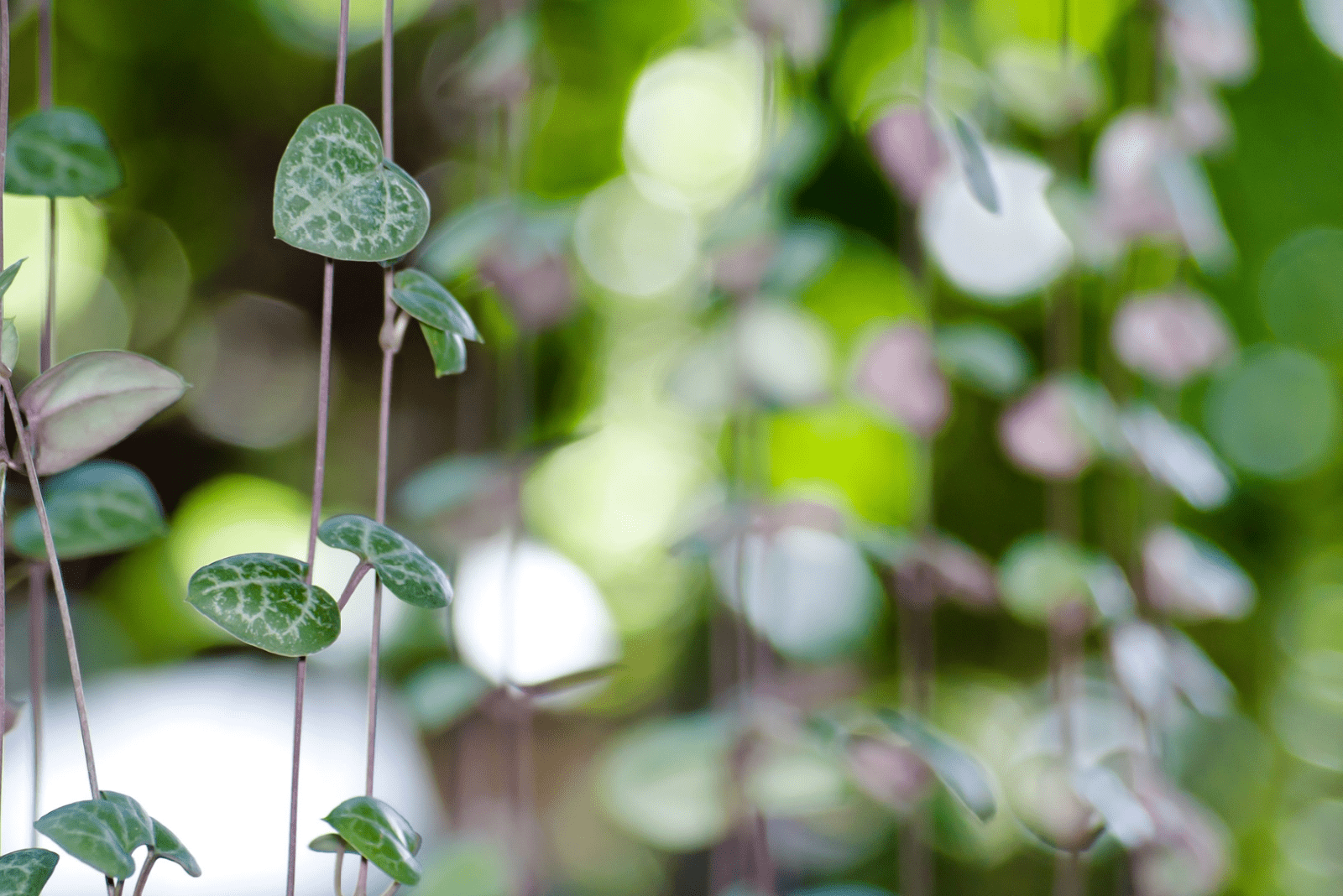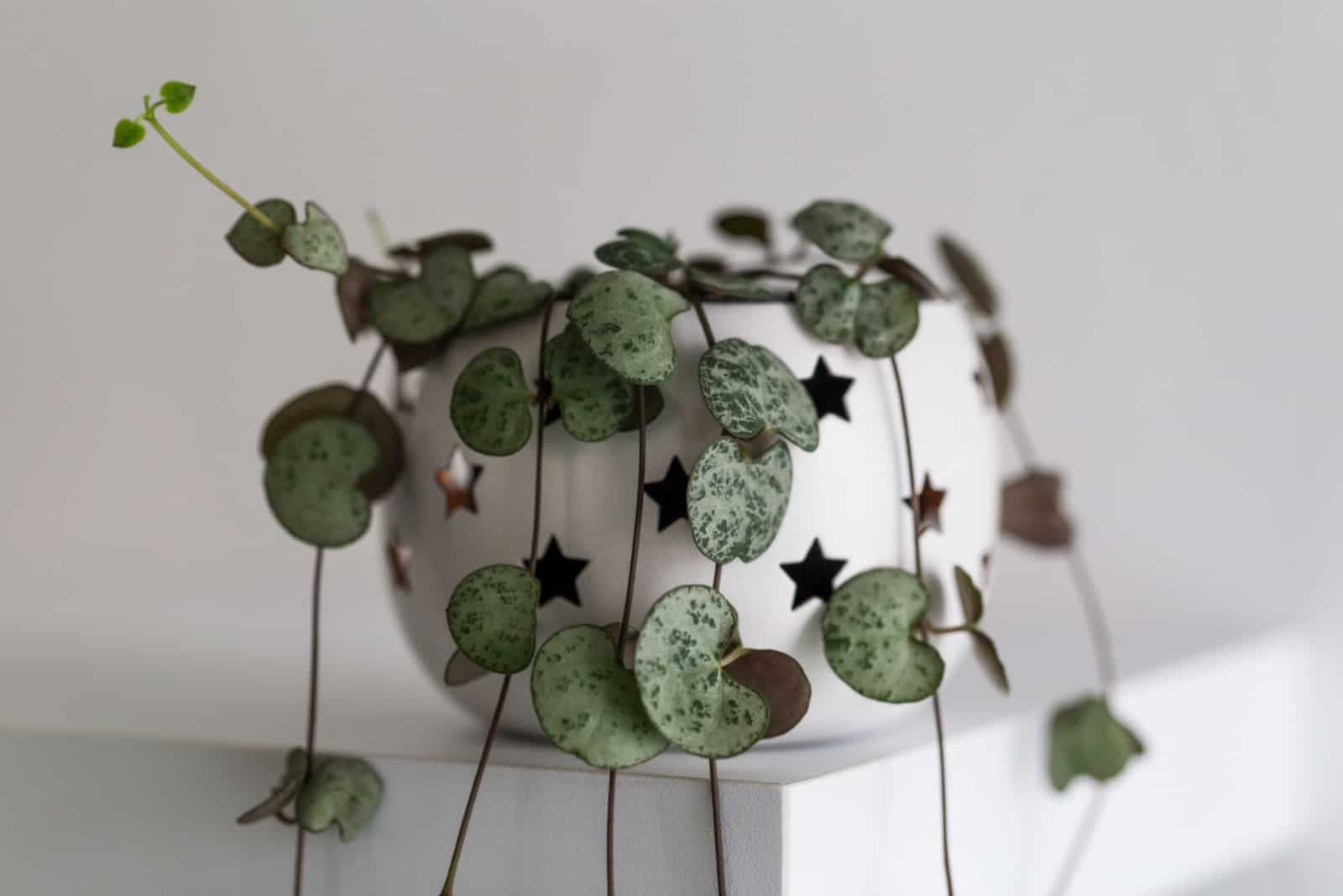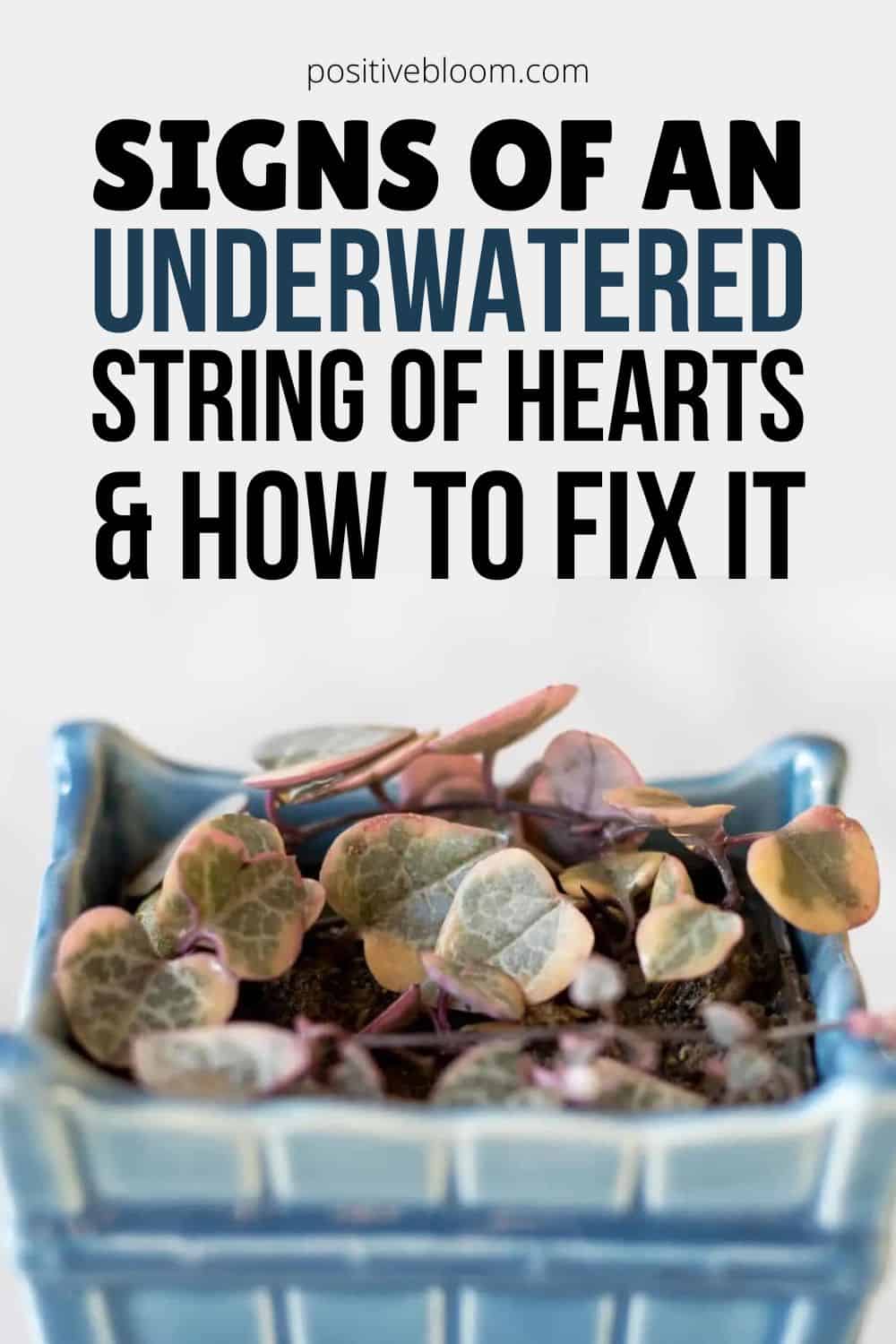I’m sure when you saw the title, you thought that I had made a mistake. Yes, a string of hearts usually has to deal with overwatering but believe it or not, you can also underwater it.
However, the consequences may not be as harsh as in the case of overwatering , but still, you need to react.
The essential thing to learn is how to identify an underwatered string of hearts and differentiate if underwatering or overwatering has caused the issue.
Why? Well, you certainly don’t want to add more water to overwatered soil!
Once you’ve determined the cause, you can start saving your plant! Don’t worry; I’ve covered everything that you need here, and I will also give you some tips on how to (and how not to) water your string of hearts.
Let’s start!
Signs Of An Underwatered String Of Hearts
Even though the string of hearts is renowned for its ability to withstand drought, there are times when it can be lacking moisture.
The signs of an underwatered string of hearts include dry soil and shriveling, curling, browning, or thinning leaves.
Let’s get straight to the point!
Leaves Curling And Shriveling
When your string of hearts has been left in dry soil for an extended period, the leaves may respond to the lack of water by curling and shriveling.
But, it’s not always the case that we have accidentally forgotten to water our houseplants . We may be watering them but so lightly that the roots are absorbing all of the water quickly.
This sweetheart vine initially grows in drier climates and doesn’t receive water frequently. But these plants receive so much water during heavy rainfalls, and their semi-succulent leaves can store some for later.
Due to this feature, it’s quite hard to underwater your string of hearts, and the far more common mistake is that we overwater it.
Brown Leaves
It’s a bit tricky to determine if browning has occurred due to underwatering, as it may also have other causes, such as high temperatures and an inadequate potting mix .
The first thing that you’ll notice are brown tips on the leaves; then the leaves will wrinkle, and eventually, the entire surface will turn brown.
Once you notice brown leaves, your string of hearts is already heavily affected, and the leaves are most likely dead. So, the best option is to remove them.
Whenever discoloration occurs, it’s best to remove the leaves as otherwise, they’ll take the nutrients from the other leaves and cause further damage.
Thin Leaves
The string of hearts ‘ succulent leaves have a fleshy texture; if they lack water, they’ll look thin and papery.
Succulent leaves store water to help the plant resist prolonged periods of drought in their natural habitat.
Therefore, as they lose water, they also lose their fleshy appearance. So, browning, thinning, yellowing, and wrinkling are sure signs of underwatering .
Dry Soil
If a string of hearts’ soil is completely dry, you most likely have an underwatering problem. If you’ve watered your Ceropegia woodii and the soil starts to dry up rapidly, the plant has probably lacked water for an extended period of time.
Additionally, dry soil will begin crumpling and appear more compact.
The soil will also develop a waxy layer if it lacks water for an extended period of time, which will result in poor water absorption.
Underwatered vs Overwatered String Of Hearts Plant
Now, we come to the trickiest part when it comes to water issues with the rosary vine plant. The hardest thing to decide is if you are dealing with an underwatered or overwatered string of hearts .
That’s why I’ve made a list of the signs that may tell you that your string of hearts is receiving too much water. The symptoms of an overwatered string of hearts are yellow leaves , root rot , edema, mushy soil, and an unpleasant smell.
Let’s dig deeper!
Yellow Leaves
Remember that the sweetheart vine plant has sensitive leaves; they are the first ones that will suffer if your plant is dealing with water issues.
If a string of hearts plant’s leaves turn yellow, overwatering is most likely the cause.
Why do plants that receive too much water develop yellow leaves ? An iron deficiency is explicitly brought on by overwatering , which creates nutrient deficiencies in the root system.
By overwatering , you are actually washing away all of the nutrients that are necessary for optimal growth.
When this is the case, your string of hearts needs to be observed more closely.
Root Rot
Ceropegia woodii and succulents have a lot in common. As you may already be aware, succulents are prone to root rot .
The aeration in the root system is disturbed when the soil becomes wet, leaving the plant vulnerable to diseases, primarily fungus. Fungi are a nuisance because they break down the tissue of plant roots ; another problem is that they spread quickly, and as a result, the leaves turn yellow .
Not removing the plant from the pot each time you have a concern makes it difficult to recognize this indicator. So, yellow leaves indicate that the plant should be further examined.
Another technique that I use to determine whether there is a problem with a string of hearts’ roots is smell the soil after I’ve noticed that it’s wet and the leaves are yellow.
The soil will have a foul odor and appear mushy .
Since the health of the roots is crucial to the overal health of the string of hearts , I advise you to take action as quickly as possible in this situation.
Remember that healthy roots should be greyish-white, so if they are brown or black and mushy , you are dealing with root rot .
Edema
One of the most common disorders to affect succulents is the notorious edema. A string of hearts is known to have many succulent characteristics. So, the main job of the rosary vine ‘s leaves is to transpire water from the roots.
When there’s excess water in the soil, the roots will absorb more, and the leaves won’t be able to transpire it all, and as a result, they will burst.
If edema affects your plant, you’ll notice black or brown spots on the leaves.
If this occurs, all is not lost. Keep reading to find out how to keep your priceless houseplant alive!
How To Tell If The Soil Is Getting Too Much Or Not Enough Water?
If you are unsure what has caused the issues with your string of hearts, you should examine the moisture level in the soil.
There are various techniques for figuring out if the soil requires more or less water.
Start with the most basic method, which only involves your eyes. Look at the color of the sweetheart vine soil; if it is darker, you may want to wait before watering.
Of course, this strategy isn’t always effective, but you can rely on it if you’ve been growing plants for a while.
Putting a finger in the soil, close to the plant, is the second option, and is also the one that most gardeners choose. I assure you that, as time passes, you will become accustomed to this approach.
Insert your finger two or three inches into the string of hearts soil and check the moisture. Alternatively, use a wooden stick.
You can also lift the pot to examine the moisture content. Of course, this method isn’t suitable for larger plants; imagine raising a Banyan fig.
However, none of these methods can guarantee that your plant is actually receiving the right amount of water. The most accurate option is to get a moisture meter, which can determine the precise moisture content of the soil and they are also reasonably priced on Amazon .
How To Revive Ceropegia Woodii
Luckily, you can do a couple of things to revive your chain of hearts . This includes changing your watering habits, adjusting the light, increasing the humidity, choosing a new pot, repotting, and propagating .
Let’s get into details!
Change Your Watering Habits
It takes time to figure out the watering needs of each houseplant . When it comes to a string of hearts, it’s quite resistant to drought, but it needs more frequent watering than other succulent -like plants.
To create an appropriate watering schedule, you’ll need to meet the other requirements too, such as adequate lighting, humidity, or potting mix . Keep reading to find out exactly how and when to water your string of hearts.
Adjust The Light
Direct sunlight is responsible for fast water evaporation from the soil. So, you’ll need to find the right location for your string of hearts to get enough light .
Search for a spot where this Ceropegia plant can receive dappled, filtered, bright light . I suggest placing it near a south-facing window, where it will get the right amount of indirect light .
I know that you have a specific spot in mind for putting your string of hearts in, so if that spot is near a window that receives direct sun , put sheer curtains up to give it some shade.
Increase The Humidity
Ceropegia woodii prefers moderate humidity levels and won’t grow in high humidity, especially during dormancy .
However, if the humidity is too low, the air gets too dry, causing the soil to lose water faster. You might be frequently watering, but a low humidity leads to faster water evaporation and underwatering .
If the humidity level in your home is too low, consider increasing it. You can place your string of hearts next to other indoor plants , place a pebble tray underneath, or use a humidifier to increase the humidity.
Choose An Adequate Pot
The essential thing to ensure, for most of your houseplants, is a well- draining soil . Purchasing a pot with drainage holes will contribute nicely to its drainage.
Also, the material of which your pot is made may aid in this draining. Choose terracotta or plastic pots instead of ceramic ones.
Pay attention to the size of the pot; you don’t want to place your string of hearts in too large a pot as such pots need more soil. If the pot has too much soil, the plant will retain moisture around its roots and this will cause them to rot.
Use The Right Potting Mix
What this plant needs is well-draining and porous soil. So, you’ll need to choose materials that will improve drainage and promote airflow.
Additionally, the soil shouldn’t be too fertile as this may cause your string of hearts to become leggy .
You can go with a ready made succulent soil or cactus soil mix or make your own.
For example, you can use regular potting soil to add a little bit of organic material (not too much) to the soil. Then, you should add some material that will improve drainage and promote airflow. The best option by far is perlite . Finally, you’ll need coarse sand and pine bark (or orchid bark).
Mix 3 parts potting soil with 3 parts perlite , 1 part coarse sand, and 1 part pine bark, and there you go; a perfect homemade potting mix for your string of hearts!
Repotting
Repotting your string of hearts can help to bring back its original glory. Luckily, it’s a simple process, and it’s easy to deal with the bulbous string of hearts roots that are commonly known as aerial tubers .
First, you’ll need to prepare a couple of things. You’ll need a fresh potting mix (I described the perfect one above), a new pot (1–2 inches larger than its current one), and sanitized scissors.
Now, follow these steps!
1. Remove the sweetheart vine from the pot. Pulling the plant from the pot sounds like the easiest thing to do but remember that easy doesn’t always mean good. That applies to this situation. Pulling may damage the string of hearts’ roots, so tip its pot to one side and let your rosary vine slide out.
2. The roots should be completely visible, so remove all the extra soil around them. Once the roots are visible, inspect them carefully. If you spot any damaged root, cut it with sanitized scissors.
3. Fill the pot with soil and place your string of hearts in the center. Add more soil until you can see that all of the roots are covered and the plant stands firm.
4. Water your repotted string of hearts to help it to adapt.
Propagation
Sometimes, plants may seem really weak, and the best option is to propagate them. The easiest way to propagate the string of hearts plant is to use the stem cutting method. You can also use the individual leaves or tubers for propagation .
You can root chain of hearts cuttings in water or soil. To take the cuttings, choose a part of the vine that is 4 inches long with a couple of healthy leaves attached. Also, the chain of hearts cutting should have at least two internodes.
Let’s see how to propagate in water and soil.
Water Propagation
Here are the steps to root the string of heart cuttings in the water!
1. Take a jar and pour lukewarm water into it.
2. Submerge the bottom part of the cutting (one node should also be immersed). Please don’t immerse the leaves as they can quickly soften and rot if placed in water for an extended period.
3. Make sure to change the water frequently and react quickly if you notice that the water in the jar smells terrible and is brown, because this means that some of the pieces have already begun to decay. Pour fresh water in after removing the rotten parts.
4. When the new roots reach a length of about half an inch, plant them in the new soil .
Soil Propagation
Here are the steps for rooting the cuttings in the soil!
1. Get the pot ready. Water the potting mix sparingly because wet soil will lead to root rot .
2. Make a few holes for your cuttings.
3. Apply rooting hormone to the leaf nodes.
4. Place the nodes in the soil and add more soil.
5. Cover the pot with a plastic bag, place a heating mat underneath, and place your container in bright indirect light . Once the new plant is established, continue with the usual chain of hearts plant care .
How To Water A String Of Hearts
Now that you’ve discovered the signs of underwatering and overwatering and learned how to revive the plant, it’s time to find out all about its watering requirements in more detail!
There are two watering techniques that gardeners usually use; top and bottom watering.
Water that is applied to plants from the top of the soil sinks to the bottom, and the soil is saturated to the point where the extra water drains through the drainage holes .
In the case of bottom watering, the soil slowly absorbs water, ensuring enough moisture, without the soil staying waterlogged.
I highly recommend you water the string of hearts using the bottom watering technique.
When To Water
A rule of thumb is to water this Ceropegia plant twice a month during the growing season . This implies that the watering schedule is different during winter.
Cut back on watering your rosary vine during the winter months as it goes into dormancy, meaning that it doesn’t need the energy that it spends growing in the warmer months.
Always check the moisture content before watering using the tips I’ve provided above. That’s the best way to avoid overwatering .
Also, don’t forget about your plant for too long; you won’t be pleased with what you see when you do remember to water it again!
Water Quality
Surprisingly, the type of water you use for plants makes a difference when it comes to watering.
Why is that? For plants, a fluorine and chlorine accumulation can be detrimental, so we should consider alternatives to tap water.
Your string of hearts will grow best if you water it with filtered or rainwater.
Common Mistakes When Watering
Every indoor plant hates being overwatered . One of the things many growers do (and it’s wrong) is forget to water their plants. Then, they water constantly to ‘make it up’, which leads to excess water in the soil, and we all know how that ends.
Another mistake is constantly watering your plant so we can take ‘a break’ and stop watering for a month. Now, we also know how that ends.
Problems will arise in each scenario. The point is to create a watering routine for yourself that isn’t the result of speculation. I advise following the straightforward method; water when the soil is dry, and don’t water when it’s wet! But please, check your plants regularly.
I know how breathtaking the leaves of a variegated string of hearts look, and I’m sure you have the best intentions to keep them watered and clean. BUT, the leaves are susceptible, and watering them may cause them to soften and start rotting.
One more thing that sounds great is to wake up, have breakfast, check on Instagram, and water out plants during the hottest part of the day.
Please don’t do this either (this doesn’t apply to breakfast and Instagram). Always water your string of hearts in the morning to help the water from the soil evaporate gradually, as that’s the only way to provide enough moisture for the roots.
And the last common mistake is the one I discussed earlier, water type. Use filtered or rainwater for your precious string of hearts!
String Of Hearts Care Guide
Here is a table to show you a string of hearts’ growing requirements.
Light : A string of hearts needs a lot of bright indirect light for optimal growth. Keep it away from direct sunlight , and use a grow light if you’re unsure about the light level.
Temperature : Rosary vine plants grow best in warm temperatures as they originate from South Africa and don’t take well to extremes. Too much cold or excessively high temperatures may quickly kill it.
Humidity : A string of hearts prefers moderate humidity levels, and just as with temperatures, don’t go with extremes.
Soil : A well-draining, porous succulent soil mix works great for Ceropegia plants. If you decide on regular potting soil , add perlite and coarse sand to help it drain better.
Watering : Water when the soil dries out entirely.
Fertilizing : Feed your string of hearts regularly using fertilizers with lower concentrations of nitrogen, as too much may cause the leaves to become soft. Fertilizers made for succulents work best.
Repotting : If the plant is entirely healthy, repot it every few years.
Pruning : You can prune the vines to achieve the desired look or prune if the plant becomes leggy .
Common issues : The chain of hearts isn’t prone to pests, but the ones that may occur are mealybugs . Other issues are related to overwatering and overfertilizing.
Wrapping Up
Realizing that you have an underwatered string of hearts may be pretty disheartening, as I’m sure you love your plant and did your best to meet its requirements.
After reading this article, you’ll know how to differentiate between overwatering and underwatering and how to save your string of hearts.
But now you also know everything about watering and caring for this plant, so nothing can stop you from becoming the best plant grower ever!
Until next time!
Like this post? Share or pin it for later!

